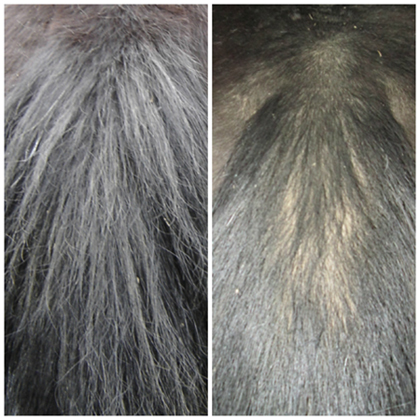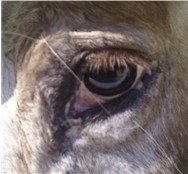Horse Allergies: Causes and Treatment
Insects, Dust and Food...Oh My!
Horse allergies are very similar to human allergies. Just like people, equines can suffer from airborne, seasonal, insect and food allergies. And just like people, allergy symptoms in horses can range from a slight runny nose to diarrhea.
 Hair loss due to knat allergies
Hair loss due to knat allergiesBecause the symptoms of equine allergies can mimic other diseases, determining weather or not a horse has allergies can be rather tricky. Unless you find an obvious correlation between your horse and the offending allergen, you may need your vet’s assistance to figure it out.
Horse Allergies and Insects
Sweet itch is the term used to describe allergies to no-see-ums (also called punkies, biting gnats, sandflies and midges). These are tiny blood sucking insects that secrete saliva when they bite the horse. Horses with sweet itch are usually affected on the poll, mane, and tail; but usually not the belly. These tiny flies are most active at dawn and dusk.
Allergies to the horn fly tend to affect the head, neck and belly; especially the midline on the horses belly. The bites from the horn fly are clearly obvious on the skin. Allergies to stable flies affect the eyes, back, neck, chest and legs of a horse. Horn flies and stable flies are active during the day time. Insect allergies are most prevalent during the summer months.

Symptoms of Allergies to Insect Bites
- Itchy skin
- Redness and inflammation
- Hair loss
- Weeping skin at the bite site
- Crusting on the skin
- Horse rubbing on posts ect…
- Excessive mutual grooming between horses
- Tail swishing and irritation
- Hives
Treatment for Insect Allergies
If your horse is allergic to no-see-ums bring them inside during dawn and dusk hours if possible, as those insects tend to say outside. Installing netting over windows and door openings is helpful. If you do not have access to stables, the next best thing is a full body fly sheet that covers the mane, and tail; and a fly mask that protects the ears as well.
Fly repellents don’t tent to be very effective for sweet itch. Many repellents only kill the fly after they have bitten the horse. By then it’s too late because the horse has already been exposed to the allergen.
Fly sheets and mask offer horses partial protection from daytime insects. Fly repellents used on the legs and belly are about the best you can do for the lower half of the body. Using a feed through fly control will help keep the daytime-active fly population down.

Airborne Horse Allergies – Dust, Mold and Pollen

There are only a few things you can do to help control airborne allergies. If possible, try to house your horse in non-dusty conditions. This is not always practical, depending on were you live. If you live in a very dry dusty area, water your horses hay down to keep the dust at a minimum, at least for their feed.
Never feed dusty or moldy hay or grains…ever. This can cause emphysema (heaves). Heaves can also be caused from chronic exposure to musty, moldy stable environments. Keep dusty or moldy bedding to a minimum. Horses with mold allergies will do far better if pastured out in the open air.
There is no cure for heaves or emphysema. The best medicine is prevention.
Symptoms of Airborne Allergies
- Watery eyes
- Persistent cough
- Wheezing
- Labored breathing
- Runny nose
- Heave line
If you suspect your horse is allergic to an airborne allergen and you can rule out dust and mold, your vet can perform an allergy test on your horse just like doctors do for humans. The hair is shaved and the skin is exposed to various allergens in a grid pattern. The horse is then treated according to the findings. The horse may be treated with antihistamines. Of course removing exposure to the allergen is best, if the allergen can be identified and it is practical to do so.

Horse Allergies – Food Allergies
Horse allergies to food are not uncommon, especially Alphalpha hay. To find out which food it is, you will have to put your horse on an elimination diet. Feed your horse only one food stuff for a two week period, perhaps your local grass hay. If your horse is having no reaction, add grain back into their diet. If the reaction comes back you’ll know it is something in the grain.
If your horse is having a reaction to the hay you’ll need to switch to a different kind. Despite the temptation to avoid the offending hay, make the switch gradually. There is no need to add horse colic to the mix! Continue this process of elimination until you identify the offending feed type. Just make sure you make all your feed changes safely and gradually. See quality hay to avoid horse allergies.
Horses that have had upset stomach and diarrhea from food allergies can benefit from electrolytes to replace lost salts and probiotics to help replenish the healthy gut bacteria. These can be obtained from feed stores or your local vet.
Symptoms of Food Allergies
- Hives
- Swelling at the shoulders or belly
- Diarrhea
- Bloody nose
- Runny nose
- Teary eyes

Horse Allergies – To Products
Just like people, horses can be allergic to products like shampoo, fly sprays, neoprene cinches, and horse blankets and so on. With these types of allergies you’ll see irritation localized at the contact spot…hives, swelling or itching. With a little detective work on your part it is usually not too hard to figure out which product is causing the trouble.
With observation and a little knowledge, you can protect your horse from potential allergens. Consult with your vet for the best allergy treatments for your horse.
This information is written for the horseman to better understand and cope with the variety of disease and injury that can occur during the course of horse ownership. Always consult with your Veterinarian regarding the care and treatment of your equine.
Return to top of Horse Allergies page

